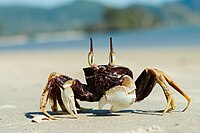
Photo from wikipedia
AIM: The high species richness of the Indo‐Australian Archipelago (IAA) marine biodiversity hotspot has been attributed to three competing hypotheses: Centre of Origin/Centre of Overlap/Centre of Accumulation. While most phylogeographic… Click to show full abstract
AIM: The high species richness of the Indo‐Australian Archipelago (IAA) marine biodiversity hotspot has been attributed to three competing hypotheses: Centre of Origin/Centre of Overlap/Centre of Accumulation. While most phylogeographic studies testing these hypotheses have focused on marine fishes, we provide a new perspective on this evolutionary important question by examining the population genetics of the horned ghost crab Ocypode ceratophthalmus sensu lato (Ocypodidae) whose distribution spans the entire Indo‐Pacific and contains at least two colour morphs. LOCATION: Indo‐Pacific region, spanning from East Africa, India, East Asia to Central Pacific. METHODS: Population genetics analyses based on mitochondrial COI and nuclear NaK intron sequences of O. ceratophthalmus from 39 sites throughout the Indo‐Pacific. RESULTS: We found at least three genetically distinct geographical clades in O. ceratophthalmus, corresponding to the east, west and central region of the species’ range. Divergent clades were found to have originated in the peripheral Central Pacific and West Indian Ocean. Populations at the eastern margin of IAA harbour the highest genetic diversity, due to the co‐existence of east and central clades in these populations. MAIN CONCLUSIONS: Peripheral isolation plays an important role in shaping evolutionary history of this species. Particularly, secondary dispersal of divergent lineages from the Central Pacific contributes to the high diversity found in the IAA. Thus, the Centre of Accumulation hypothesis best describes the evolutionary and demographic history of O. ceratophthalmus.
Journal Title: Journal of Biogeography
Year Published: 2018
Link to full text (if available)
Share on Social Media: Sign Up to like & get
recommendations!